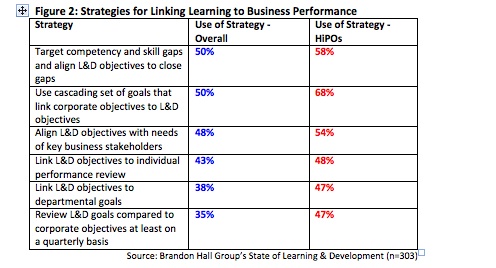
Managing your talent is about providing the knowledge necessary to build a high-performance workforce and develop future leaders. The skills that are developed are the new currency, with the potential to make a tremendous impact on your business.
On the flip side, a lack of skills can cripple an organization. There are many ways to address these skill gaps, but first, it is imperative to identify where they exist and to what extent. Brandon Hall Group’s 2015 HCM Outlook Survey showed that 72 percent of organizations viewed assessing critical skills within their workforce as a priority or critical to the business.
Companies no longer can rely on talent acquisition to solve their skills challenges. Learning and development is necessary to transform the workforce by developing the right skills in the right people so the organization can continue to grow and move forward.
Brandon Hall Group’s research has identified these challenges. The just-released 2015 State of Learning Study provides insight into how high-performing organizations—those that have shown overall improvement across employee engagement, customer satisfaction, organizational revenue/performance, voluntary turnover, and organizational productivity—are delivering learning to ensure their workforce has the skills to make them successful.
Recommendations from the research:
- Have a strong, skills-focused talent acquisition strategy, but don’t stop there.
- Identify needs via assessments and gap analysis.
- Create a learning environment that fosters frequent, continuous development.
- Leverage technology to deliver learning targeted directly at specific skills gaps.
- Continuously measure the impact learning is having on both the learners and the organization.
The Skills Gap Is Real
Approximately one-quarter of companies say their strategy for a skilled workforce is primarily to hire properly trained people. Another 17 percent say they have a basic onboarding program, but nothing beyond that. That means that 41 percent of companies are relying on people to come through the door with the optimal skill set and continue to meet the organization’s need from then on. The fallacy in this approach becomes quickly apparent when we see that 90 percent of companies say they have difficulty hiring skilled workers.
The disconnect here is huge. If organizations say they can’t find enough skilled workers to hire, yet their only source for skills is the hiring process, how can business objectives possibly be met?
To make matters worse, even when companies manage to hire skilled workers, it can be difficult to hold onto them.
Almost one-third of companies report skilled worker turnover of more than 10 percent. This means that the very people an organization needs the most are the most likely to walk out the door. In an environment when skills are at such a premium, these workers are the ones with the most opportunities for mobility. Also, skilled workers are more likely to realize they are not developed properly and seek out an organization that provides more development opportunities.
The Impact is Real
This perfect storm of too few skilled workers coming in and too many leaving has a real, tangible effect on companies. Companies report challenges growing the business, keeping up with competitors, and maintaining quality.

Identifying the Problem
Knowing your critical roles and planning for them are two different things. Brandon Hall Group’s 2015 Talent Shortage Study found that 24 percent of companies have not identified their needs for skilled workers. Nearly half of those that have identified their needs have only done so for the next 12 months. In other words, there are many companies that don’t even know what they need in terms of skills beyond the immediate future. From the Skills Gap Study, we find that even if companies know what they need, only 21 percent have assessed their entire current skilled workforce against those future needs. The majority of organizations have no idea if the people they currently have in place possess the skills to meet the company’s needs. What’s worse is that 58 percent of organizations report having no company-wide plan in place for filling the skill gaps.
Learning Can Close the Gap
So if companies can’t find skilled workers and they keep losing them, what’s the solution? After identifying what and where the gaps are, it is time for Learning and Development to take center stage and make sure those gaps are closed. Our research finds that high-performing organizations (HiPOs) recognize the role learning plays more so than others. One of the first things we see from our 2015 State of Learning and Development Study is that HiPOs put more effort into linking learning to performance.

At every juncture, HiPOs are doing a better job of linking learning to performance, including using L&D to target and address skill gaps and competencies. As noted earlier, 24 percent of companies said they meet their needs for skilled workers primarily by hiring them, rather than developing them. Unfortunately, those numbers are essentially identical for HiPOs, but the high-performing companies are 45 percent more likely to provide regular, ongoing development: 32 percent of HiPOs vs. 22 percent of the overall group.
Companies are finding that in order to effectively develop the right skills within their workforce, learning has to move beyond traditional methods alone. A company can no longer expect to drop people into classrooms and have them walk out highly skilled and ready to make an impact. In fact, in terms of the most effective learning modalities, the classroom is actually fourth.

It is not that the classroom is dead or even dying. In fact, it is still the No. 1 method of delivering learning as far as quantity is concerned. Rather, the new reality is that if an organization expects to have a highly skilled workforce, it needs to be prepared to develop those workers in a variety of ways, the most effective being coaching and mentoring. We also see informal learning and on-the-job exercises at the top, which lends great credence to the 70/20/10 learning model, where 90 percent of learning is informal and experiential and only 10 percent is formal. Organizations are recognizing that they have to do something different. We asked companies how often they expected their people to interact with learning in order to be effective at their jobs—61 percent expect learning activity at least weekly and 91 percent expect learning activity at least monthly.
When 61 percent of companies expect people to learn either weekly or more frequently, it cannot be accomplished via a series of hour-long classes and in-depth e-learning modules. Organizations need to expand the learning ecosystem to include social, mobile, videos, and other short-form, contextual learning.
Measurement
The final piece of the puzzle is measurement. By measuring the quality of learning and how it affects behaviors and performance, it becomes far easier to target programs to close specific skill gaps. The problem is, organizations still struggle to measure learning, especially when it is not formal.
The No. 1 thing that gets measured by all companies is completion of courses, used by nearly three-quarters of companies to measure at least 50 percent of their learning. However, only 19 percent of companies say this is an effective measurement. The most effective metrics are:
- Reduction in errors/accidents
- Time to effectiveness
- Increased productivity
- Meeting corporate objectives
- Ability to perform new tasks
Fewer than 35 percent of companies use these more effective measurements to a great extent. Instead they rely on smile sheets, questionnaires, and surveys, which provide great feedback on how well received a program is, but offer no insight into how well it is helping the company get to where it wants to go.
Conclusion
It is clear that companies of all industries are having some degree of difficulty with skills in their workforce. Some can’t find skilled workers, some can’t keep skilled workers, some don’t develop skilled workers, and many suffer from all three challenges. Part of the learning strategy should focus on skills and competencies to ensure the learning programs, tools, and technologies are being leveraged effectively to close or at least mitigate any gaps.
David Wentworth is Principal Learning Analyst for Brandon Hall Group, an independent human capital management (HCM) research/analyst firm. The company provides insights around key performance areas, including Learning and Development, Talent Management, Leadership Development, Talent Acquisition and HR/Workforce Management.




